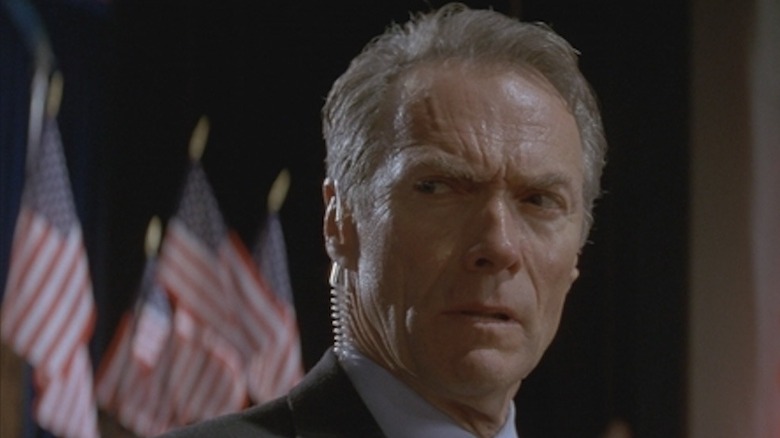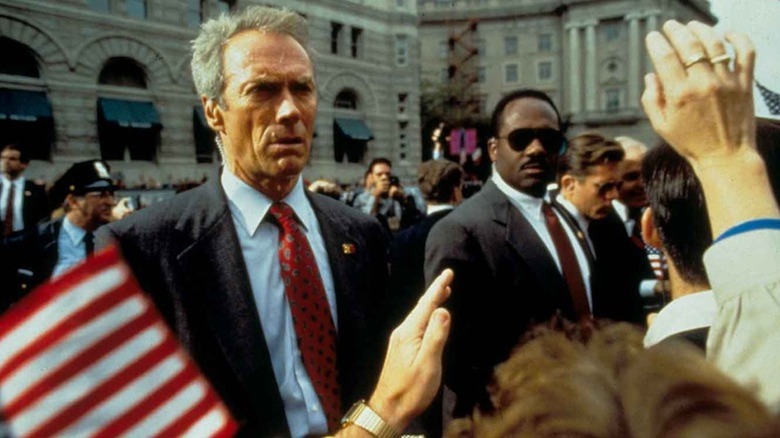Clint Eastwood's Iconic Last Action Movie Role Has A 96% Score On Rotten Tomatoes
1993 was Clint Eastwood's victory lap year. After winning the Best Picture and Best Director Oscars for "Unforgiven" in March (which, along with being a critical success, also grossed $101 million at the North American box office), he would be the toast of Hollywood as he promoted two very different movies: "In the Line of Fire" and "A Perfect World." The latter was the most eagerly anticipated of the two, if only because it would mark his directorial follow-up to "Unforgiven," as well as pair him onscreen with 1990's Best Director winner Kevin Costner.
"In the Line of Fire" was not, on the surface, an odd movie. Directed by Wolfgang Petersen, the celebrated German director of "Das Boot," it was an action-thriller with an irresistible hook. Eastwood had been cast as Frank Horrigan, a long-in-the-tooth Secret Service Agent who finds himself being targeted by a psychopath who plans to kill the President of the United States. Horrigan is no longer on protective detail, and this is for a very good reason: he is the only member of the agency who was a part of John F. Kennedy's motorcade in Dallas on the day of the President's assassination. A distressed Horrigan gets himself placed back on protective duty, believing he's the one agent best equipped to catch this deranged killer.
But "In the Line of Fire" was a unique project for Eastwood not just because he didn't direct it. And it's possible this aspect of the film's production allowed it to stand apart from the kinds of movies he'd been making prior to "Unforgiven" and much of what he'd go on to make.
In the Line of Fire was both a departure and return to form for Clint Eastwood
When Clint Eastwood founded The Malpaso Company in 1968, he was one year removed from becoming the biggest Western star on the planet. He was already the top Western star outside of the United States, but, due to legal concerns about the obvious similarities between "A Fistful of Dollars" and Akira Kurosawa's "Yojimbo" (obvious because they were both working from Dashiell Hammett's "Red Harvest" and "The Glass Key"), United Artists was hesitant to release the "Dollars Trilogy" in America until they knew they wouldn't be sued. When "A Fistful of Dollars," "For a Few Dollars More," and "The Good, the Bad and the Ugly" hit U.S. theaters in 1967, Americans were suddenly just as gaga for Clint as the rest of the world.
Eastwood boldly bet on himself, and that bet paid off handsomely. From that point forward, he only made movies through Malpaso. This makes "In the Line of Fire" an extreme rarity in that it was produced through Castle Rock Entertainment. This was Eastwood's first non-Malpaso movie since 1970's "Kelly's Heroes," and it was truly Petersen's film. It's definitely the most directed movie Eastwood had been in since Don Siegel's "Dirty Harry," which was refreshing because the star's idea of an action movie at this point was the rock-bottom idiocy of "The Rookie."
This was basically Eastwood's last pure action flick, and it's a beaut. He did direct and star in the Brian Helgeland-scripted "Blood Work" in 2002, but it's a moody "Dirty Harry" riff that's short on high-caliber excitement. So let's consider "In the Line of Fire" Eastwood's farewell to the crowd-pleasing actioner. And since it's on our mind, let's settle in for a rewatch because Petersen's movie hits the mark every time.

